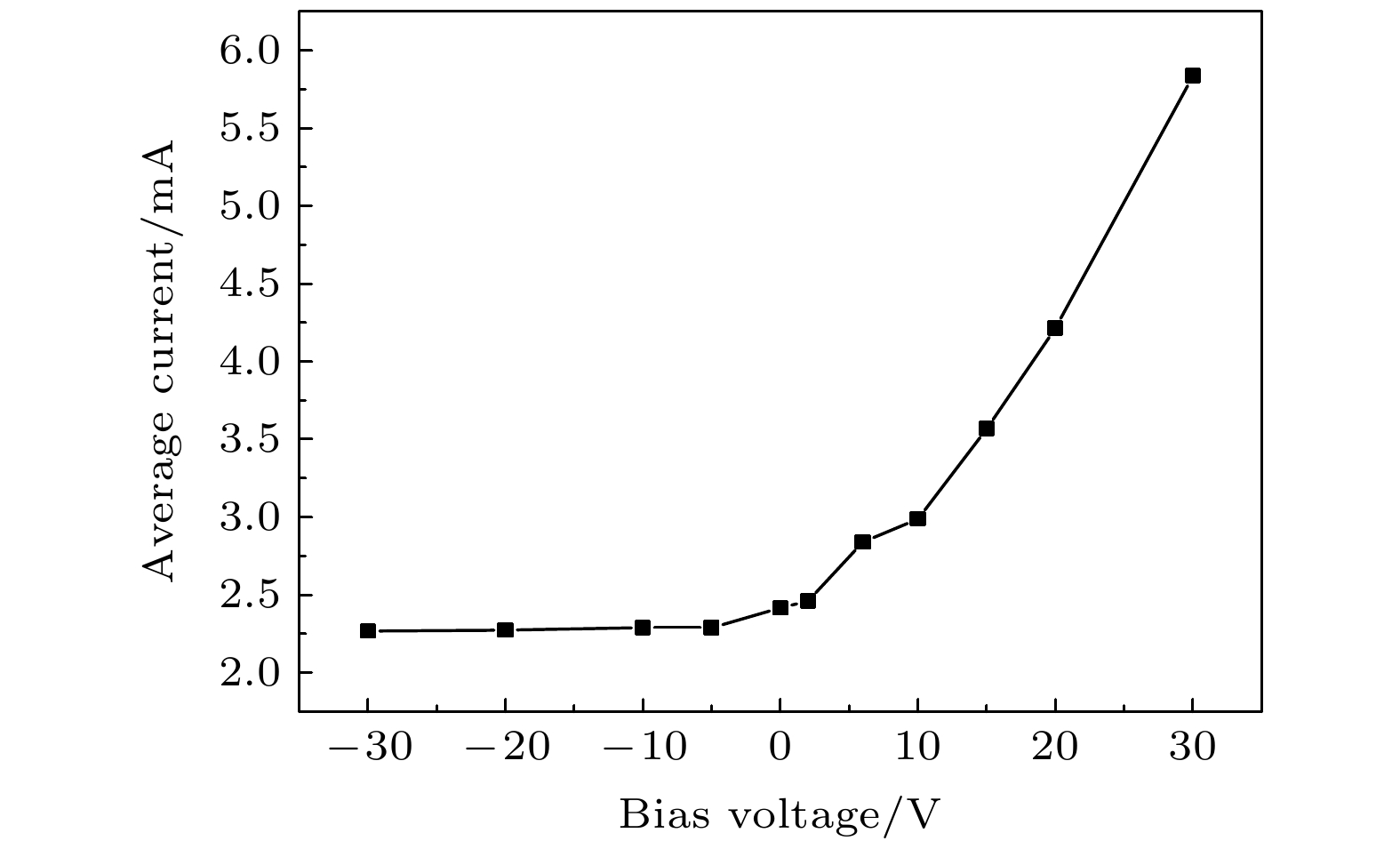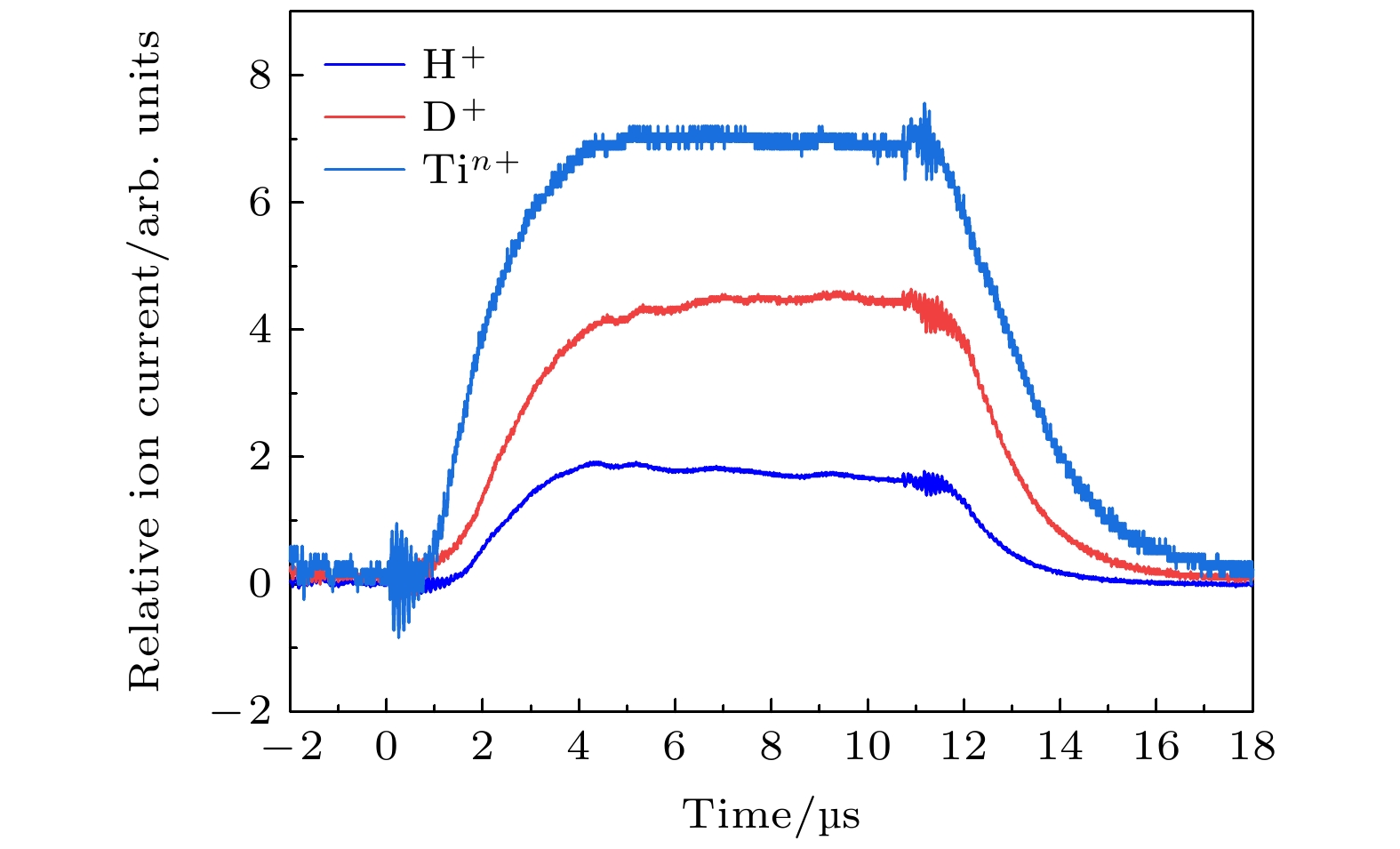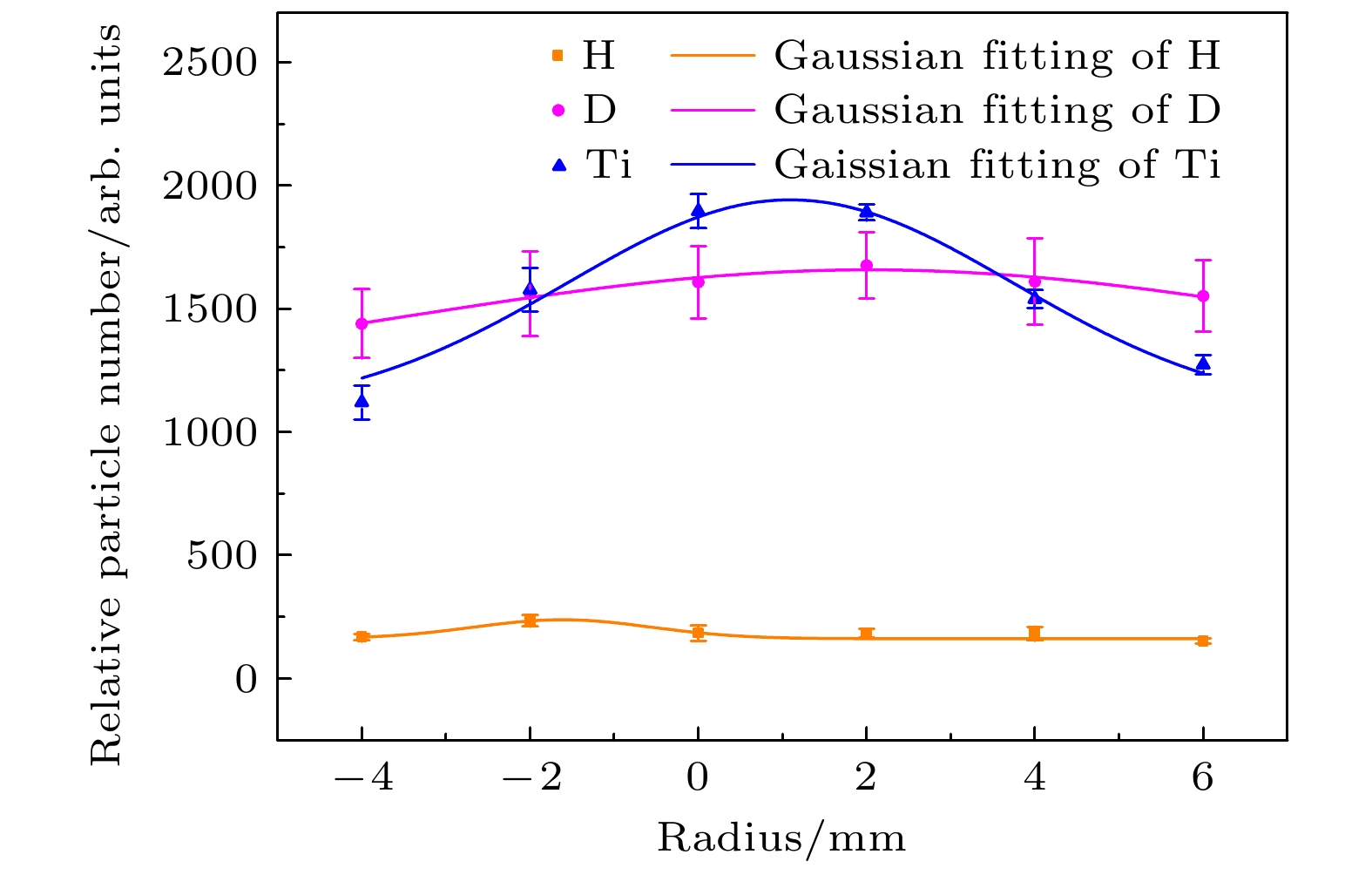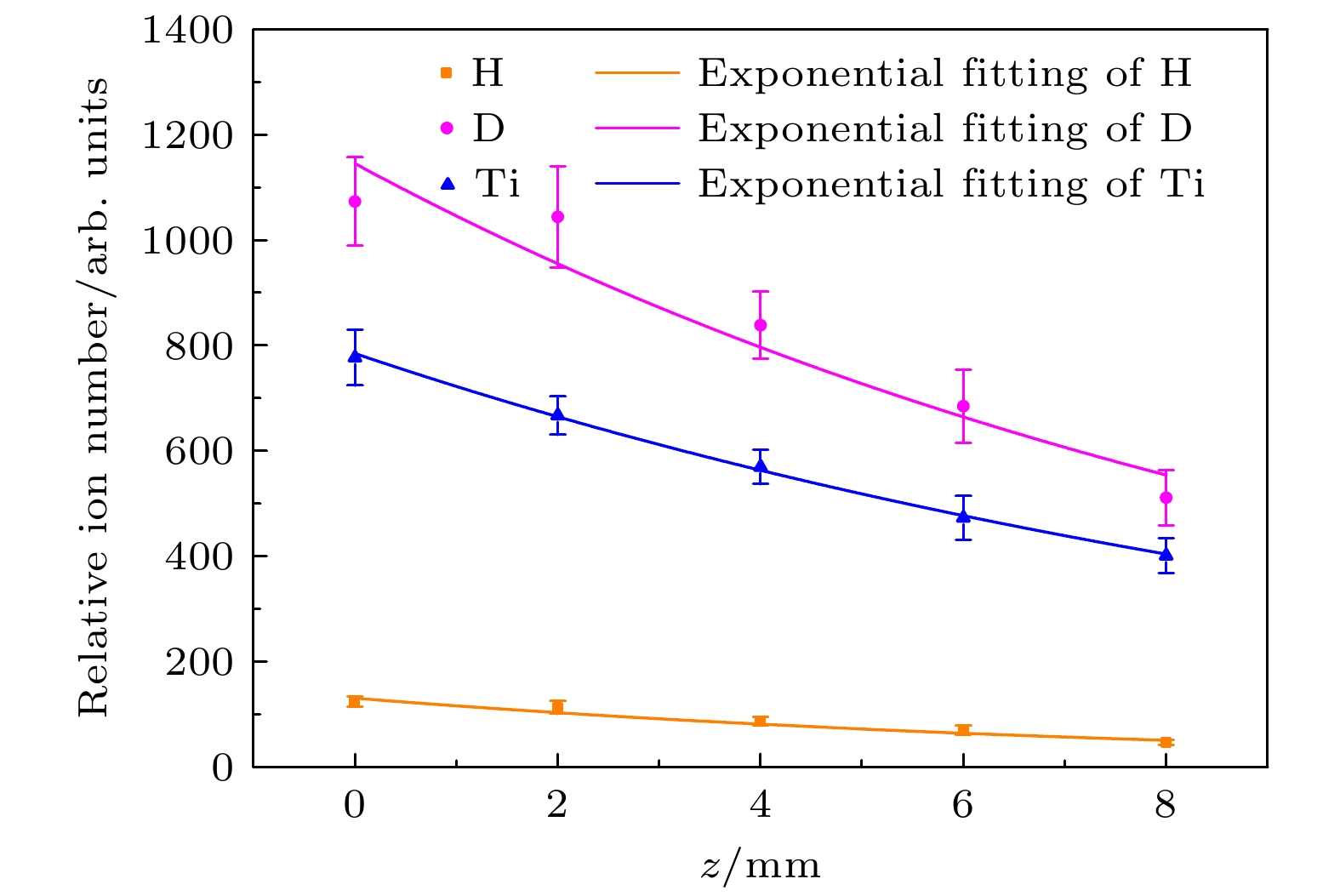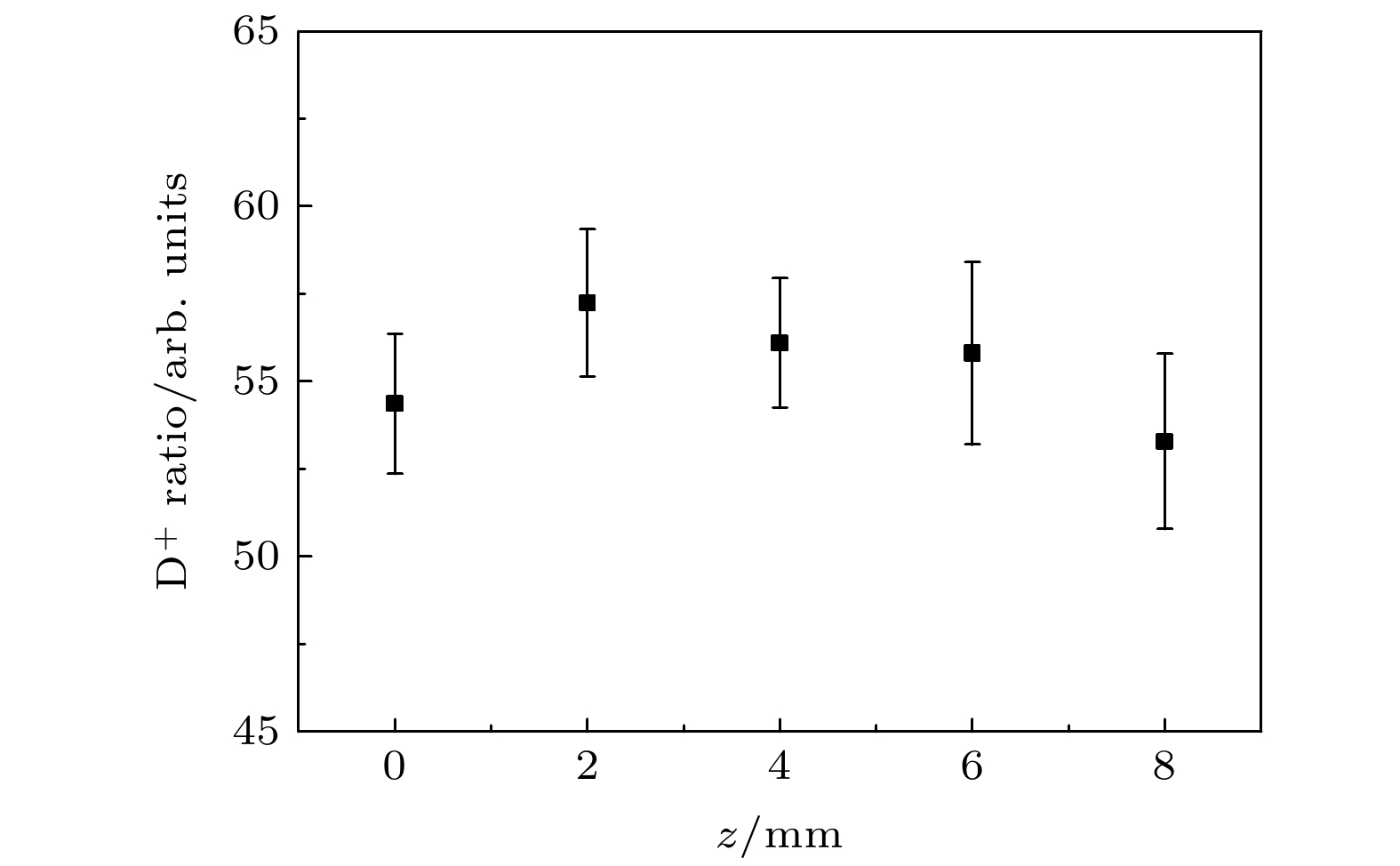-
真空弧放电等离子体含有多种离子成分, 并且各离子在空间上具有不同的分布规律. 本文针对金属氘化物电极真空弧离子源, 搭建了一台紧凑型磁分析装置, 用来研究放电等离子体中氘离子与金属离子的空间分布. 当离子源弧流为100 A左右时, 该装置能有效地传输引出束流, 并且具有较好的二次电子抑制效果, 可准确获得各离子流强. 利用该装置测量并获得了氘化钛含氘电极真空弧放电等离子体内氘离子和钛离子空间分布规律, 结果表明: 径向上, 氘离子和钛离子都呈高斯分布, 但氘离子分布均匀, 而钛离子相对集中在轴线附近, 导致轴线附近氘离子比例最低; 轴向上, 所有离子数量都以自然指数函数减少, 而且相对幅度接近, 所以氘离子比例几乎不变. 本文研究结果不仅有助于理解真空弧放电等离子体膨胀过程, 还可以指导金属氘化物电极真空弧离子源及其引出设计.There are many kinds of ions in vacuum arc discharge plasma, which have different distributions in space. In this paper, a compact magnetic analyzer is developed for studying the spatial distribution of deuterium ions and metal ions in vacuum arc discharge with occluded deuterium electrode. When the arc current is about 100 A, the device can effectively transfer the ion beam with good secondary electron suppression, and can accurately obtain the ion current intensity. The spatial distribution of deuterium ions and titanium ions in the vacuum arc discharge with TiD electrode are measured by this device. The results show that both deuterium ions and Titanium ions are Gaussian distribution in the radial direction, but deuterium ions are evenly distributed, while titanium ions are relatively concentrated near the axis, resulting in the lowest proportion of deuterium ions near the axis. Along the axis, the number of all ions decreases as a natural exponential function, and the relative magnitudes are approximately equal, so the proportion of deuterium ions is almost constant. The results of this study not only help to understand the plasma expansion process of vacuum arc discharge, but also guide the design of vacuum arc ion source with occluded deuterium electrode and its ion extraction.
-
Keywords:
- vacuum arc ion source /
- metal deuteride /
- magnetic mass spectrometer /
- spatial distribution
[1] Nazarov K M, Muhametuly B, Kenzhin E A, Kichanov S E, Kozlenko D P, Lukin E V, Shaimerdenov A A 2020 Nucl. Instrum. Methods Phys. Res., Sect. A 982 164572
 Google Scholar
Google Scholar
[2] 魏国海, 韩松柏, 陈东风, 王洪立, 郝丽杰, 武梅梅, 贺林峰, 王雨, 刘蕴韬, 孙凯, 赵志祥 2012 核技术 35 821
Wei G H, Han S B, Chen D F, Wang H L, Hao L J, Wu M M, He L F, Wang Y, Liu Y T, Sun K, Zhao Z X 2012 Nucl. Tech. 35 821
[3] Whetstone Z D, Kearfott K J 2014 J. Radioanal. Nucl. Chem. 301 629
 Google Scholar
Google Scholar
[4] Zaker S, Nafchi S, Rastegarnia M, Bagheri S, Sanati A, Naghibi A 2020 Petroleum 6 170
 Google Scholar
Google Scholar
[5] El-Taher A, Khater A E M 2016 Appl. Radiat. Isot. 114 121
 Google Scholar
Google Scholar
[6] 王刚, 于前锋, 王文, 宋钢, 吴宜灿 2015 物理学报 64 102901
Wang G, Yu Q F, Wang W, Song G, Wu Y C 2015 Acta Phys. Sin. 64 102901
[7] Walko R J, Rochau G E 1981 IEEE Trans. Nucl. Sci. 28 531
[8] Aleksandrov V D, Bogolubov E P, Bochkarev O V, Korytko L A, Nazarov V I, Polkanov Y G, Ryzhkov V I, Khasaev T O 2005 Appl. Radiat. Isot. 63 537
 Google Scholar
Google Scholar
[9] Shkol’nik S M 2001 IEEE Trans. Plasma Sci. 29 675
 Google Scholar
Google Scholar
[10] Barengolts S A, Karnaukhov D Y, Nikolaev A G, Savkin K P, Oks E M, Uimanov I V, Frolova V P, Shmelev D L, Yushkov G Y 2015 Tech. Phys. 60 989
 Google Scholar
Google Scholar
[11] Nikolaev A G, Oks E M, Frolova V P, Yushkov G Y 2019 Russ. Phys. J. 62 1109
 Google Scholar
Google Scholar
[12] Nikolaev A G, Yushkov G Y, Savkin K P Oks E M 2012 Rev. Sci. Instrum. 83 02A503
 Google Scholar
Google Scholar
[13] Nikolaev A G, Yushkov G Y, Savkin K P Oks E M 2013 IEEE Trans. Plasma Sci. 41 1923
 Google Scholar
Google Scholar
[14] Nikolaev A G, Savkin K P, Yushkovet G Y, Oks E M 2014 Rev. Sci. Instrum. 85 02B501
 Google Scholar
Google Scholar
[15] Brown I G 1994 Rev. Sci. Instrum. 65 3061
 Google Scholar
Google Scholar
[16] Chen L, Jin D Z, Cheng L Shi L, Tan X H, Xiang W, Dai J Y, Hu S D 2012 Vacuum 86 813
 Google Scholar
Google Scholar
[17] Lan C H, Long J D, Zheng L, Peng Y F, Li J, Yang Z, Dong P 2014 Chin. Phys. Lett. 31 105202
 Google Scholar
Google Scholar
[18] Lan C H, Long J D, Zheng L, Dong P, Yang Z, Wang T, Li J 2015 Chin. Phys. Lett. 32 095201
 Google Scholar
Google Scholar
[19] 郑乐, 蓝朝晖, 龙继东, 彭宇飞, 李杰, 杨振, 董攀, 石金水 2014 核技术 37 010202
 Google Scholar
Google Scholar
Zheng L, Lan C H, Long J D, Peng Y F, Li J, Yang Z, Dong P, Shi J S 2014 Nucl. Tech. 37 010202
 Google Scholar
Google Scholar
[20] 张华顺 1987 离子源和大功率中性束源 (北京: 原子能出版社) 第93−100页
Zhang H S 1987 Ion Source with High-Power Neutral Beam Sources (Beijing: Atomic Energy Press) pp93−100 (in Chinese)
[21] 刘猛, 柯建林, 黄刚, 梁建华, 刘湾, 娄本超, 卢彪 2012 核电子学与探测技术 32 786
 Google Scholar
Google Scholar
Liu M, Ke J L, Huang G, Liang J H, Liu W, Lou B C, Lu B 2012 Nucl. Electron. Detect. Technol. 32 786
 Google Scholar
Google Scholar
-
图 1 磁分析装置示意图(1-离子源, 2-引出电极, 3-地电极, 4-磁铁区域, 5-金属离子收集极, 6-氘离子收集极, 7-氢离子收集极, 8-三维位移平台)
Fig. 1. Schematic of the magnetic analysis device (1-ion source, 2- extraction electrode, 3-grounding electrode, 4- magnetic field area, 5-collector for metal ions, 6-collector for deuterium ions, 7-collector for hydrogen ions, 8-three dimensional displacement platform).
-
[1] Nazarov K M, Muhametuly B, Kenzhin E A, Kichanov S E, Kozlenko D P, Lukin E V, Shaimerdenov A A 2020 Nucl. Instrum. Methods Phys. Res., Sect. A 982 164572
 Google Scholar
Google Scholar
[2] 魏国海, 韩松柏, 陈东风, 王洪立, 郝丽杰, 武梅梅, 贺林峰, 王雨, 刘蕴韬, 孙凯, 赵志祥 2012 核技术 35 821
Wei G H, Han S B, Chen D F, Wang H L, Hao L J, Wu M M, He L F, Wang Y, Liu Y T, Sun K, Zhao Z X 2012 Nucl. Tech. 35 821
[3] Whetstone Z D, Kearfott K J 2014 J. Radioanal. Nucl. Chem. 301 629
 Google Scholar
Google Scholar
[4] Zaker S, Nafchi S, Rastegarnia M, Bagheri S, Sanati A, Naghibi A 2020 Petroleum 6 170
 Google Scholar
Google Scholar
[5] El-Taher A, Khater A E M 2016 Appl. Radiat. Isot. 114 121
 Google Scholar
Google Scholar
[6] 王刚, 于前锋, 王文, 宋钢, 吴宜灿 2015 物理学报 64 102901
Wang G, Yu Q F, Wang W, Song G, Wu Y C 2015 Acta Phys. Sin. 64 102901
[7] Walko R J, Rochau G E 1981 IEEE Trans. Nucl. Sci. 28 531
[8] Aleksandrov V D, Bogolubov E P, Bochkarev O V, Korytko L A, Nazarov V I, Polkanov Y G, Ryzhkov V I, Khasaev T O 2005 Appl. Radiat. Isot. 63 537
 Google Scholar
Google Scholar
[9] Shkol’nik S M 2001 IEEE Trans. Plasma Sci. 29 675
 Google Scholar
Google Scholar
[10] Barengolts S A, Karnaukhov D Y, Nikolaev A G, Savkin K P, Oks E M, Uimanov I V, Frolova V P, Shmelev D L, Yushkov G Y 2015 Tech. Phys. 60 989
 Google Scholar
Google Scholar
[11] Nikolaev A G, Oks E M, Frolova V P, Yushkov G Y 2019 Russ. Phys. J. 62 1109
 Google Scholar
Google Scholar
[12] Nikolaev A G, Yushkov G Y, Savkin K P Oks E M 2012 Rev. Sci. Instrum. 83 02A503
 Google Scholar
Google Scholar
[13] Nikolaev A G, Yushkov G Y, Savkin K P Oks E M 2013 IEEE Trans. Plasma Sci. 41 1923
 Google Scholar
Google Scholar
[14] Nikolaev A G, Savkin K P, Yushkovet G Y, Oks E M 2014 Rev. Sci. Instrum. 85 02B501
 Google Scholar
Google Scholar
[15] Brown I G 1994 Rev. Sci. Instrum. 65 3061
 Google Scholar
Google Scholar
[16] Chen L, Jin D Z, Cheng L Shi L, Tan X H, Xiang W, Dai J Y, Hu S D 2012 Vacuum 86 813
 Google Scholar
Google Scholar
[17] Lan C H, Long J D, Zheng L, Peng Y F, Li J, Yang Z, Dong P 2014 Chin. Phys. Lett. 31 105202
 Google Scholar
Google Scholar
[18] Lan C H, Long J D, Zheng L, Dong P, Yang Z, Wang T, Li J 2015 Chin. Phys. Lett. 32 095201
 Google Scholar
Google Scholar
[19] 郑乐, 蓝朝晖, 龙继东, 彭宇飞, 李杰, 杨振, 董攀, 石金水 2014 核技术 37 010202
 Google Scholar
Google Scholar
Zheng L, Lan C H, Long J D, Peng Y F, Li J, Yang Z, Dong P, Shi J S 2014 Nucl. Tech. 37 010202
 Google Scholar
Google Scholar
[20] 张华顺 1987 离子源和大功率中性束源 (北京: 原子能出版社) 第93−100页
Zhang H S 1987 Ion Source with High-Power Neutral Beam Sources (Beijing: Atomic Energy Press) pp93−100 (in Chinese)
[21] 刘猛, 柯建林, 黄刚, 梁建华, 刘湾, 娄本超, 卢彪 2012 核电子学与探测技术 32 786
 Google Scholar
Google Scholar
Liu M, Ke J L, Huang G, Liang J H, Liu W, Lou B C, Lu B 2012 Nucl. Electron. Detect. Technol. 32 786
 Google Scholar
Google Scholar
计量
- 文章访问数: 6572
- PDF下载量: 99
- 被引次数: 0













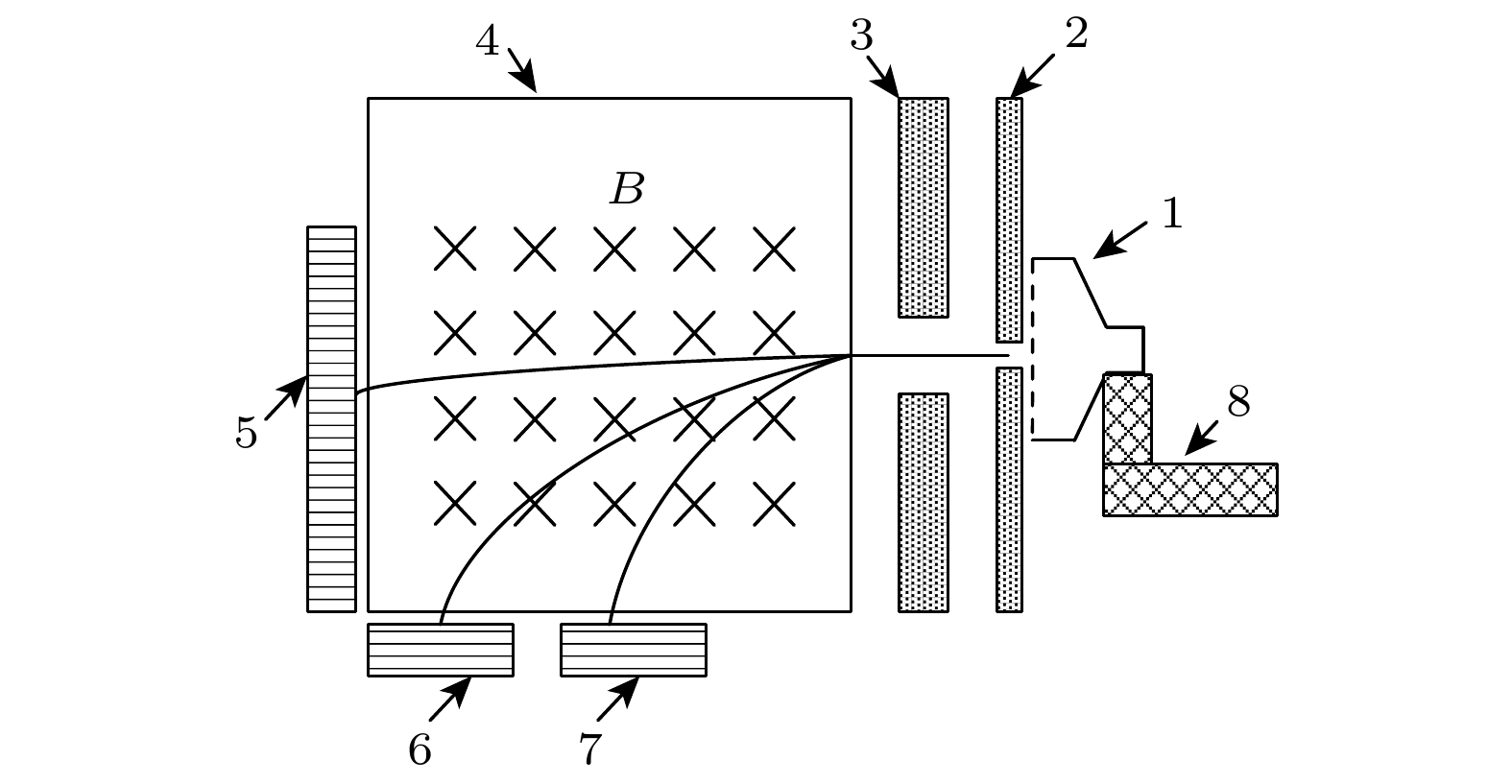
 下载:
下载:


